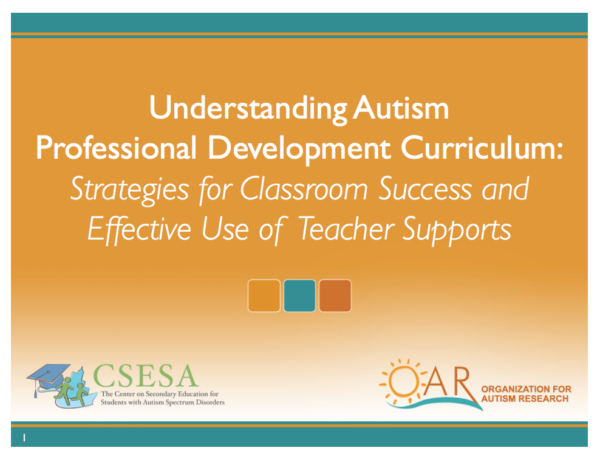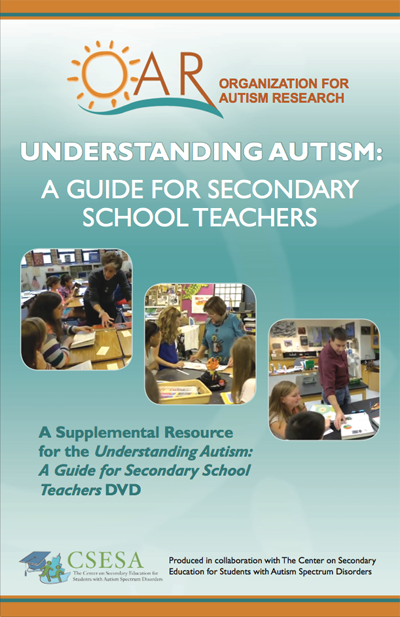
Video Presentations
The Understanding Autism: Professional Development Curriculum is a comprehensive professional development training tool that prepares secondary school teachers to serve the autism population.
This page includes two presentations:
- Understanding Autism: Professional Development Curriculum
- Part 1: Characteristics and Practices for Challenging Behavior
- Part 2: Strategies for Classroom Success and Effective Use of Teacher Supports
- Understanding Autism: A Guide for Secondary School Teachers
Understanding Autism: Professional Development Curriculum
Developed in collaboration with the Center on Secondary Education for Students with Autism Spectrum Disorders (CSESA), the Understanding Autism Professional Development Curriculum is built around two 75-minute presentations that school staff can adapt to meet any schedule constraints:
This ready-made, flexible resource supports all types of professional development – large group (e.g. staff meetings or in-services), small teams (e.g. professional learning communities and department meetings), self-study, and/or one-on-one coaching. Any school or district staff members who are familiar with autism can implement the curriculum. Each presentation includes video clips and comes with slide-by-slide notes for facilitators, handouts, and activity worksheets to help participants apply learned concepts to their own classrooms.
Part 1: Challenging Behaviors
Characteristics and Practices for Challenging Behavior
Printable Materials
Part 2: Classroom Strategies
Strategies for Classroom Success and Effective Use of Teacher Supports
Printable Materials
Presentation B
Understanding Autism: A Guide for Secondary School Teachers
Understanding Autism: A Guide for Secondary School Teachers provides teachers with strategies for supporting their middle and high school students with autism. We produced it in collaboration with Fairfax County (VA) Public Schools and with financial support from the American Legion Child Welfare Foundation and the Doug Flutie Jr. Foundation for Autism
At the end of this segment, viewers will be able to:
- Describe how autism impacts learners
- Indicate how the characteristics of autism impacts individuals in a school setting
- Understand that autism manifests itself differently in individual learners
At the end of this segment, viewers will be able to:
- Match interventions to learner strengths, skills, and interests
- Describe how priming can be used in a classroom setting
- Discuss the types of academic supports that a learner might need to be successful in a general education setting
- Create a home base for a student with autism
- Provide examples of visual supports to enhance the skills acquisition of learners with autism
- Integrate reinforcement into the daily schedule of the student with autism
At the end of this segment, viewers will be able to:
- Understand that meltdown behavior is not purposeful for the learner on the spectrum
- Describe the stages of a meltdown
- Discuss interventions that can be used at each of the stages of a meltdown
At the end of this segment, viewers will be able to:
- Describe how to use information from the IEP to develop an implementation plan for the learner with autism in the general education classroom
- Identify the multiple ways that general and special educators can work together to support a learner with autism in the general education classroom
- Discuss guidelines for supporting a paraprofessional in working with the learner with autism in the general education classroom




